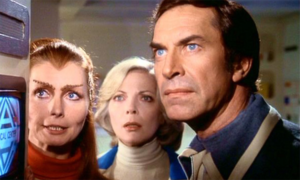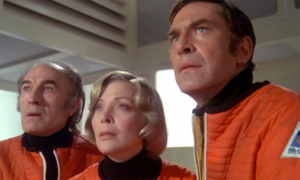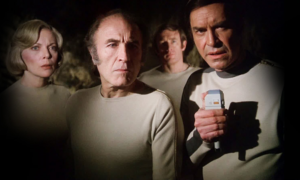On 13 September 1999, the following things took place: a terrorist bomb was set off in Moscow, Liam Gallagher and Patsy Kensit gave birth to a baby boy, and Benjamin Bloom, the American educational theorist, died. Only one of the three really constitutes news (unless you’re a hardcore Oasis fan). What didn’t happen was that the Moon was ripped from Earth’s orbit, hurtling the 311 men and women of Moonbase Alpha deep into space, unable to return home. This was the catastrophe that, in 1975, kicked off Gerry and Sylvia Anderson’s Space: 1999, a series that barely got a mention in the obituaries of Gerry Anderson when he died on Boxing Day 2012. It was the puppet (or ‘Supermarionation’) shows – Thunderbirds, Stingray, Captain Scarlet and the rest – that predictably dominated the column inches, with not much mention of his three live-action series: UFO, Space: 1999 and Space Precinct.
It seems strange, because Space: 1999 was, at the time, the most expensive British TV series ever produced. With a record-breaking budget (£3.5 million for the first series) and two major-league stars, in many ways this was Gerry Anderson’s greatest dream realised. But this would be the first show he didn’t have total creative control over, with a whip-cracking New York office micro-managing the series from across the pond. It was a show that could have been one of the TV greats, had he kept his nerve and not tried to be, in his own words, “Mr Nice Guy”.
Along with his wife and creative comrade, Sylvia, Gerry had always lusted after the American TV market. In the early days of ITV, when most shows were being made on scratchy, 405-line blur-o-vision videotape, was canny enough to know the commercial benefits of celluloid. All of his shows from Supercar onwards would be made on 35mm film, and featured American voice artists to help make the product as desirable as possible to US buyers.
But Gerry had spent much of the Sixties wanting to get out of the puppet rut he found himself in. His big flesh-and-blood break came in 1970 with UFO, about a secret(ish) military organisation, SHADO, set up to defend Earth from aliens. The series appeared to finally give him the international smash he had always dreamed of (even Thunderbirds hadn’t caught fire in the US).
With good ratings across the Atlantic, a second series was a given. However, ITC’s New York office had noted that the stories set on SHADO’s moonbase rated noticeably better than the Earth-based episodes. Couldn’t the Andersons retool the series and jettison the Earth locales? Intrigued by the challenge, Gerry got to work, flash-forwarding 20 years and shifting the action to an expanded SHADO moonbase. ‘UFO: 1999’, as it was being dubbed, soon began pre-production, with designer Keith Wilson cooking up designs of the new central set.
All seemed well, until the Andersons were called in. UFO: 1999 was cancelled. Unwilling to waste the money and man-hours that had already gone into it, the Andersons put forward a fresh proposal, unconnected to UFO. Abe Mantel, ITC’s tough-talking man in New York, was keen, but told the husband-and-wife producers that he didn’t want a series featuring people “having tea in the Midlands”, and forbade any Earth-bound settings. Gerry responded that he would “blow up the Earth” in the opening episode. Mantel warned him that might scare viewers away. “Okay, I’ll blow up the Moon then,” came the pragmatic response.

Stateside success was always the ambition, but this was the Andersons’ first time working for the New York office of ITC, the London-centric production company that had been his creative home since the early Sixties. With that partnership came more directives and more meddling than he’d ever been used to. The Andersons had enjoyed almost complete creative freedom on their previous shows, but Space: 1999 would be an experience apart. It was to be a co-production between Group Three (the company set up by Gerry and Sylvia and long-time associate Reg Hill), ITC and Rome-based company RAI (whose involvement would mean some conspicuously placed Italian actors as guest stars).
ITC insisted on parachuting in an American writer, the experienced George Bellak, to work alongside the Anderson-picked staffers. It was also ITC, not the Andersons, who picked out the show’s two main stars – Martin Landau and Barbara Bain. Sylvia Anderson had her eye on I Spy headliner Robert Culp for the lead role of Commander John Koenig (Culp had been sounded out, but took himself out of the running when he told Gerry, “I’m a great actor, but I’m an even better director and an even better writer!”), but ITC, and particularly its charismatic head, Lew Grade, wielded the greater power, and had cherry-picked the then husband-and-wife stars of Mission: Impossible as their hoped-for passport to the American networks. Bain would be cast as Helena Russell, Moonbase Alpha’s joyless medical doctor, with Landau as the base’s redoubtable commander. Thepromise of a house in Little Venice and a Rolls-Royce helped cement the deal.
There was more interference from New York with the show’s costumes. Fashionista Rudi Gernreich, who had courted controversy a few years before with his famed topless dress, was hired to design the uniforms for Moonbase Alpha’s 300-plus inhabitants – just, Anderson was told, to get his name on the credits. The results were, in Anderson’s words, “hardly spectacular.”
Although it was the Andersons who had cooked up the idea for Space: 1999, it was George Bellak who penned the pilot episode and fleshed out the series’ defining concepts. But Bellak exited Space: 1999 before the pilot had even aired, the result of one too many creative bust-ups with Gerry. Christopher Penfold, a young writer who had been a story consultant on the ITV WW2 drama Pathfinders, was to become head writer, bringing in American TV scribe Edward di Lorenzo and Irish poet Johnny Byrne as script editors.
In the pilot episode, ‘Breakaway’, the Moon is established as being a dumping ground for Earth’s nuclear waste. Commander John Koenig is introduced as the new head of Moonbase Alpha when an unknown form of electromagnetic radiation is detected. After one of the nuclear waste areas explodes, a sudden increase in magnetic radiation sets off a chain reaction that alters the Moon’s gravitational field and throws the satellite out of Earth’s orbit. The date is 13 September 1999.
Production for Space: 1999 begun in November 1973 and lasted 15 months. It wasn’t an easy shoot. For the early months of 1974, Britain’s mandatory three-day working week and the unplugging of the National Grid during the coal shortages led to Pinewood Studios employing generators to keep the electrics going. More strain was put on the production team because of the obligation to telex story outlines and scripts to New York for a thumbs-up or down. ITC New York had a lot riding on Space: 1999, and was intent on scrutinising everything Group 3 was doing at Pinewood. Johnny Byrne would later moan that “one episode [New York] would ask us to speed things up, forcing us to cut out character development; then the next episode, they asked for more character moments, which would slow down the action; then they would complain there weren’t enough pretty girls in another.”
“We had very good scripts which had to go back to the drawing board to meet a requirement which had come from Abe Mandell, who didn’t appear to have any understanding that if you take one strand out of a script, it affects everything else in the script,” said Christopher Penfold in an interview some years later. “So a lot of rewriting, needless rewriting, went on, and this had the effect of bringing the scripts further and further behind schedule. The difficulties eventually came to a head, and Gerry asked me to leave the series. I don’t remember having any severe falling out with him, but I realised the way the wind was blowing as far as story content was concerned, and I was, at that point, utterly exhausted anyway.”
Apart from Landau and Bain, the starriest name in the cast list was Barry Morse. Although British-born, the then 51-year-old had made his name as the dogged Lieutenant Philip Gerard on the Sixties American series The Fugitive. As Moonbase Alpha’s avuncular chief scientist Victor Bergman, Morse often found himself the expositional mouthpiece of the show, but in many ways he’s the warmest and most human character from that first series. “In terms of the ideas, Victor Bergman was the most interesting character of all,” recalled Penfold, “He was the person who was really manning the frontier of this environment.”
24 episodes were produced during that rocky 15-month shoot, with Penfold and Byrne taking on the bulk of the writing duties. Among the show’s repertory of directors was Charles Crichton, who had cut his teeth on a succession of Ealing comedies, as well as Brit TV veterans such as Ray Austin (The Avengers), David Tomblin (The Prisoner) and Bob Kellett (the Are You Being Served movie).
Space: 1999 debuted in the UK on 4 September 1975. Critic reactions ranged from the enthusiastic (“Space: 1999 is like Star Trek shot full of methedrine,” cooed The New York Times. “It is the most flashy, gorgeous sci-fi trip ever to appear on TV”) to the predictably sniffy (most of the others). Even science fiction titan Isaac Asimov had his say by pointing out that any explosion capable of knocking the Moon out of orbit would actually blow it apart. “So what?” Gerry shrugged. “It was science fiction, not science prediction.”

In the fallout from Series One, Johnny Byrne penned a no-holds-barred analysis of the season, breaking down its weaknesses and strengths. But New York had more drastic plans, and told Anderson that he needed an American head writer. Gerry flew over to the US, and eventually met Fred Freiberger, an experienced – if not always respected – writer-producer veteran. Initially impressed, he invited him to come on board Space: 1999.
In the UK, ratings were good, but in the US they began to sag towards the end of the series. Grade had been unable to sell Space: 1999 to any of the major networks, meaning it was being flogged on a station-to-station basis. Sadly, it wasn’t generating enough viewership for Grade to think of the series as commercially viable for a second year. Weighing up the options, Lew Grade axed Space: 1999.
But like the UFO: 1999 debacle, Gerry was nothing if not creative at a time of crisis. Together with Freiberger, he pitched a new character who they insisted would shake up life on Moonbase Alpha. ITC warily okayed a second series, but this was to be only the first of many changes for Space: 1999.
Few shows have had such a radical personality shift between series. If Series One was defined by its solemnity and barely concealed debt to 2001: A Space Odyssey, then Series Two seemed to want to be its complete opposite. Having decided that Series One was po-faced, talky and visually sterile, Freiberger’s watch words were ‘pace, action and humour’.
Out went Barry Morse’s Victor Bergman (“I would rather play with grown-ups for a while,” he told Gerry), as well as other Series One faces like Prentis Hancock, Clifton Jones and Suzanne Roquette. Added to the cast was the young and dashing Security Chief Tony Verdeschi (played by The Protectors’ Tony Anholt) and a new science officer, a shapeshifter from the planet Psychon named Maya (Catherine Schell).
New York was keen on the 31-year-old Schell, then famous for her starring role in The Return Of The Pink Panther (she had also already guest-starred in Space: 1999 in the episode ‘Guardian Of Piri’) for the role, although Gerry had favoured a young cabaret artist, only to be told by the American office, “She looks like a black hooker.”
“It was just appalling,” he recalled, “but they were calling the tune, so I had to go along with it.” When viewers tuned in for the first episode of Series Two on 4 September 1976, the changes were stark. Gone was Barry Gray’s zippy, guitar-led theme and rapid-fire ‘This Episode’ montage, replaced instead by new music from jazzster Derek Wadsworth.
The expansive Main Mission set was also junked, replaced by a more compact Command Centre, supposedly deep underground. With a shrunken budget, production designer Keith Wilson was ordered to “keep the sets small”, while the cast and crew (Landau and Bain excepted) were all forced to accept pay cuts. There was no mention of why Victor Bergman, Paul Morrow, David Kano and Tanya Alexander were suddenly absent. A scene was written for the season’s first episode, ‘The Metamorph’, that explained that Bergman had been killed by a faulty spacesuit. The scene was never even filmed, and it was like Bergman, the show’s number three, had never even existed. It would be typical of the casual disregard Freiberger had for Series One.
Story-wise, much of the second season eschewed the metaphysical obsessions of the first series. While that first run could sometimes be a bit parched and talky, Freiberger’s emphasis on action and humour often feels shoehorned. Freiberger had also been the producer of Star Trek’s final season (and was responsible for The Original Series’ most notorious episode, the comically dire ‘Spock’s Brain’), and filched that show’s trope of closing on an all-crew-together joke.

But what worked with William Shatner, Leonard Nimoy and DeForest Kelley felt forced and ill-fitting coming from the mouths of Landau and Bain. Landau had been a script fiddler even in Series One, but Series Two’s scripts came in for an even more savage bashing from the actor. He loathed one episode – ‘All That Glisters’ – so much that he scrawled on the script, “All the credibility we’re building up is totally forsaken in this script”; “…Story is told poorly”; and “The character of Koenig takes a terrible beating in this script – we’re all schmucks.” Another script had an even more merciless note left on it, directed at Freiberger: “I’m not going out on a limb for this show because I’m not in accord with what you’re doing as a result. I don’t think I even want to do the promos – I don’t want to push the show any more as I have in the past. It’s not my idea of what the show should be.”
Most people who worked on that second series agree that Freiberger was “a nice guy”, but that his storytelling sensibilities and instincts were so at odds with the cast and crew that their faith in the show was dented. “He just wasn’t writing the same series,” Johnny Byrne lamented. As Gerry recalled: “I said to him: ‘Look, if you’re going to be head writer, and I’m going to allow you to do what you want to do, then I’m going to give you the title of producer, because I’m not going to put my name as producer of the show to a format that you’re going to bend around.’”
The season’s low point came with the episode ‘The Rules Of Luton’, where Koenig and Maya visit a planet of talking plants, who, you know, really do talk. When Gerry questioned the planet’s name, Freiberger responded, “I saw it on a signpost on the way here!”
Typical of the disorder on Series Two was when deep into production, Abe Mandel told Gerry that he wanted more monsters on the show. “In America, they’re all the rage,” he told him. “Every science fiction show has to have them!” Scripts were hurriedly rewritten, with panic calls going out to latex artists, sculptors and animatronics artists.
Weeks later, while on a trip to the set, Mandel took Gerry aside. “What are you doing?” he asked. “You’ve got monsters on the show. You’ve got to stop it.”
“You were the one who said it was all the rage in the States,” replied an incredulous Anderson.
“Ah, but that’s all changed now. Monsters are out!”
Principal photography on Series Two came to an end on 23 December 1976 with ‘The Dorcons’, and cast and crew bid their farewells and went home, crossing their fingers for a third series. But Series Two had been met with a cool reception, and ITC was making plans to make the jump into feature films. Space: 1999 was again axed, this time for good.
There would be no resolution for the inhabitants of Moonbase Alpha; no final episode where they either returned or Earth or found a new home. Freiberger’s gamble had failed. Although he had brought pace and energy to the series, he’d forfeited much of what made that first season unique and beguiling.
“I tried to be Mr Nice Guy,” Gerry recalled years later, “who tried to please too many people. I think if I had been much more ruthless and said, ‘Look, get the hell out of here, otherwise we stop shooting tomorrow,’ and had totally done it my way, I honestly believe it would have stood a much better chance.”
Space 1999 is currently showing on weekdays at 6pm on the Horror Channel.
